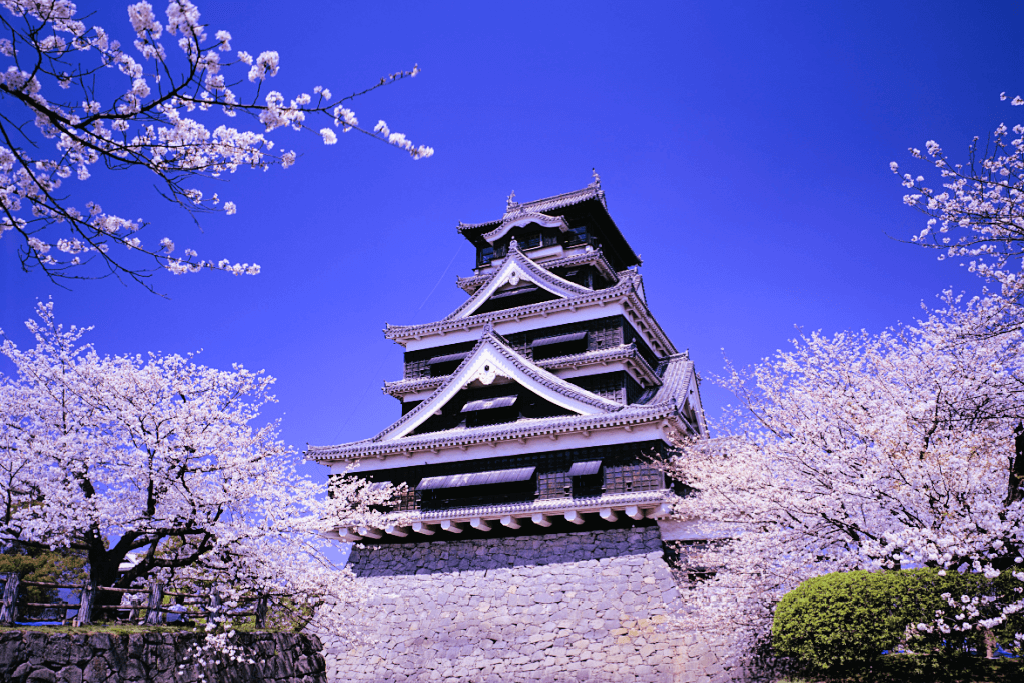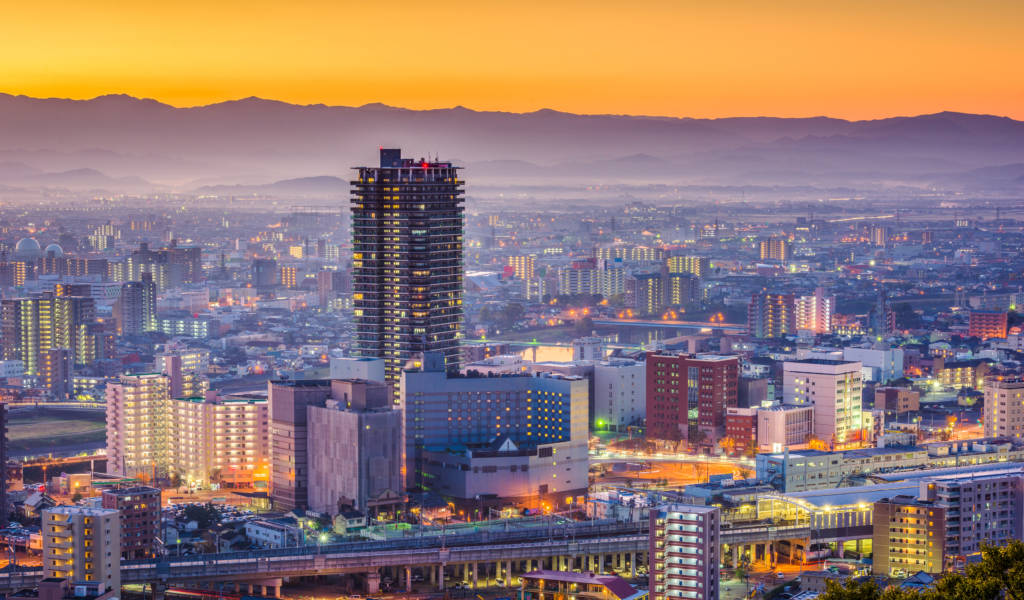



Kumamoto is a city on the Japanese island of Kyushu. Kumamoto Castle dates back to the 17th century. On the castle grounds is the reconstructed Honmaru Goten Palace with its ornate reception rooms and murals. Kumamoto Prefectural Museum of Art shows both European works and Edo-period prints. Southeast of the city center is Suizenji Garden, a Japanese landscape garden with a central pond, created in the 1630s.
The best time to visit Kumamoto depends on your preferences for weather and seasonal activities. Here's a breakdown of the ideal seasons:
Spring (March to May): This is one of the most beautiful times to visit Kumamoto, especially if you want to see the famous cherry blossoms. The weather is mild, and the city's parks, including Suizenji Jojuen Garden, bloom with stunning cherry blossoms.
Autumn (September to November): Autumn in Kumamoto brings beautiful fall foliage, with vibrant reds, oranges, and yellows. It's a great time to enjoy the outdoor parks and temples, as the weather is cool and pleasant.
Summer (June to August): Kumamoto experiences hot and humid summers. The temperatures can rise above 30°C (86°F), and it can be rainy during the rainy season (June-July). However, if you enjoy festivals, you can experience the Kumamoto Summer Festival and Hosei-ji Temple's Bon Odori (traditional dance festival).
Winter (December to February): Winter is cool, but not extreme. The temperatures rarely drop below freezing. If you like quiet travel without crowds, winter is a peaceful time to visit.
By Air:
Kumamoto is served by Kumamoto Airport (KMJ), located about 15 kilometers (9 miles) outside the city center. It's accessible via domestic flights from major Japanese cities like Tokyo, Osaka, and Fukuoka. Once at the airport, you can take a bus or taxi to the city.
By Train:
Kumamoto is well connected by rail. You can take the Shinkansen (bullet train) from Tokyo, Fukuoka, or Osaka to Kumamoto Station. The Kyushu Shinkansen offers fast and comfortable travel. The journey from Fukuoka takes about 40 minutes, and from Osaka or Tokyo, it takes about 3-4 hours.
By Bus:
There are long-distance buses available from other major cities, such as Fukuoka and Kagoshima, which are more economical but take longer than the Shinkansen.
By Car:
If you prefer driving, Kumamoto is easily accessible by car via the Kyushu Expressway from Fukuoka (approximately 2 hours) or Kagoshima (around 1.5 hours).
Kumamoto Castle 🏯
One of Japan’s most famous castles, Kumamoto Castle is a magnificent fortress with impressive architecture and a large, historic garden. Although it was damaged during the 2016 earthquake, restoration efforts are ongoing, and parts of the castle remain open to visitors. The view from the top is spectacular, especially during cherry blossom season.
Suizenji Jojuen Garden 🌳
This beautiful traditional Japanese garden is a tranquil escape in the heart of Kumamoto. It features a stunning pond, tea houses, and well-manicured landscapes, mimicking famous scenic spots like Mount Fuji. It’s especially beautiful in spring and autumn.
Shimada Museum of Arts 🎨
A modern museum in Kumamoto that exhibits traditional and contemporary Japanese art. The museum is located in a beautiful space and offers an enriching experience for those interested in Japanese culture and aesthetics.
Kato Shrine ⛩️
A serene Shinto shrine dedicated to the founder of Kumamoto Prefecture, Kato Kiyomasa. The shrine is known for its peaceful atmosphere and scenic setting, especially in spring when the cherry blossoms bloom.
Kumamoto Prefectural Museum of Art 🎨
This museum houses a remarkable collection of both Japanese and Western art, including works from famous artists. It’s located near Kumamoto Castle, so it’s easy to visit both attractions in one day.
Daimyo House 🏠
Explore the former residence of the Daimyo (feudal lord) of the region. The house has been preserved to give you a glimpse into the life of the ruling samurai class during the Edo period.
Hosokawa Mansion 🏯
The residence of the Hosokawa clan, a powerful family in Kumamoto, is another historical site that offers insight into feudal Japan. The mansion showcases beautiful gardens and architecture from the Edo period.
Mount Aso ⛰️
For nature lovers, Mount Aso is an active volcano that offers hiking, scenic views, and hot springs. The Aso caldera is one of the largest volcanic craters in the world and has several scenic viewpoints.
Kumamoto Zoo and Botanical Gardens 🦁🌺
A family-friendly destination, the zoo features a variety of animals and is home to one of Japan’s most diverse botanical gardens. It's a fun spot for both kids and adults.
Kirishima Shrine ⛩️
Located at the foot of Kirishima Mountain, this shrine is one of the most sacred places in Kumamoto, with a stunning natural setting surrounded by lush forests and waterfalls.
Amakusa Islands 🏖️
A little farther from Kumamoto, the Amakusa Islands offer picturesque landscapes, beaches, and historical sites. The area is known for its beautiful coastline and rich history related to Christianity in Japan.
Kumamoto City Transport Museum 🚗
For something a little different, visit the Kumamoto City Transport Museum to learn about the history of transportation in the region, with a special focus on the Kumamoto tram system.
Visit Kumamoto Castle:
Explore the iconic Kumamoto Castle, one of Japan's most famous castles. It’s a fascinating experience, with its grand architecture, history, and scenic views from the top. Don't miss the opportunity to visit the Honmaru Goten, the inner palace, and enjoy the beautiful Japanese gardens.
Stroll through Suizenji Jojuen Garden:
Enjoy a peaceful walk in Suizenji Jojuen Garden, a traditional Japanese garden that beautifully replicates famous landscapes. You can even try tea at the garden's tea house.
Explore Mount Aso:
Hike the slopes of Mount Aso, one of the world’s largest active volcanic craters. Enjoy breathtaking views, take a ride around the caldera, and relax in the hot springs nearby.
Attend the Kumamoto Summer Festival:
If you're visiting in the summer, take part in the Kumamoto Summer Festival, where you can experience traditional Japanese dances, fireworks, and street festivities.
Take a Boat Ride on the Shimada River:
For a serene experience, rent a boat and paddle along the Shimada River, enjoying the peaceful scenery and fresh air of the area.
Relax at Hot Springs:
After a day of sightseeing, unwind at one of Kumamoto's natural hot springs, such as those near Aso or Kusasenri.
Enjoy Local Food Tours:
Join a food tour and indulge in Kumamoto's famous dishes like Kumamoto Ramen, basashi (horse sashimi), and tonkotsu (pork broth).
Shopping at Shimotori & Kamitori Shopping Streets:
Explore the bustling shopping streets of Shimotori and Kamitori, where you can buy local crafts, souvenirs, and enjoy the lively atmosphere.
Take a Day Trip to Amakusa:
If you have extra time, head to the Amakusa Islands to explore the beautiful beaches, go snorkeling, or learn about the area’s Christian history.
Discover Kumamoto’s Museums:
Visit Kumamoto Prefectural Museum of Art and Shimada Museum of Arts to immerse yourself in traditional and modern Japanese art.
Kumamoto offers a variety of accommodation options ranging from luxury hotels to more budget-friendly stays.
Luxury Hotels:
Mid-range Hotels:
Budget Accommodation:
Ryokan:
Airbnb:
Kumamoto also has plenty of Airbnb options for those who prefer a more personalized stay, from traditional homes to modern apartments.
Kumamoto is known for its rich and unique food culture. Here are some must-try dishes and popular restaurants:
Must-try Dishes:
Popular Restaurants:
Sweets:
Historical Significance:
Kumamoto has a rich history, largely influenced by the Kato and Hosokawa clans. The city’s pride, Kumamoto Castle, stands as a testament to its feudal past. Understanding the city’s history through its museums and temples can offer you deep insights into Kumamoto’s cultural significance.
Traditional Festivals:
Kumamoto has a lively festival culture, with several important festivals throughout the year. The Kumamoto Summer Festival includes traditional Bon Odori dance, while the Kumamoto Castle Festival celebrates the city’s history with events, performances, and processions.
Crafts:
Kumamoto’s pottery, particularly Higo-yaki, is highly regarded. You can find local pottery at various shops around the city, and learning about its production methods at museums is an interesting cultural activity.
Hospitality (Omotenashi):
Kumamoto is known for its omotenashi culture, where people go above and beyond to ensure guests have a pleasant experience. This is reflected in the service you receive in restaurants, hotels, and attractions.
Traditional Japanese Tea:
Kumamoto has a long history of tea cultivation, particularly green tea. You can experience traditional Japanese tea ceremonies at local tea houses or gardens, like Suizenji Jojuen Garden.
Samurai Legacy:
The legacy of the samurai in Kumamoto can be felt throughout the city. The Hosokawa Mansion and Kato Shrine offer glimpses into the samurai’s lifestyle and history in the region.